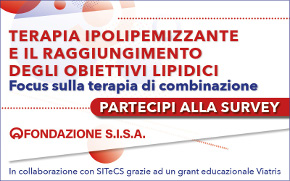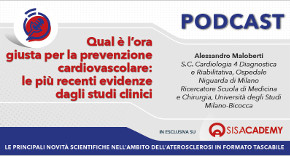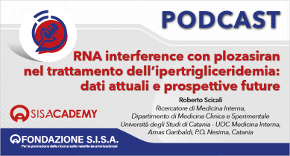 Rivista in lingua italiana
Rivista in lingua italiana
riservata ai Soci SISA
Ultimo numero:
Anno 16 • N.1/2025
Abstract
Inflammatory and Cholesterol Risk in the FOURIER Trial
Bohula EA, Giugliano RP, Leiter LA, Verma S, Park JG, Sever PS, Lira Pineda A, Honarpour N, Wang H, Murphy SA, Keech A, Pedersen TR, Sabatine MS.
Circulation 2018;138:131-140
BACKGROUND: In the FOURIER trial (Further Cardiovascular Outcomes Research With PCSK9 Inhibition in Patients With Elevated Risk), the PCSK9 (proprotein convertase subtilisin/kexin type 9) inhibitor evolocumab reduced low-density lipoprotein cholesterol (LDL-C) and cardiovascular risk. It is not known whether the efficacy of evolocumab is modified by baseline inflammatory risk. We explored the efficacy of evolocumab stratified by baseline high-sensitivity C-reactive protein (hsCRP). We also assessed the importance of inflammatory and residual cholesterol risk across the range of on-treatment LDL-C concentrations.
METHODS: Patients (n=27 564) with stable atherosclerotic cardiovascular disease and LDL-C ≥70 mg/dL on a statin were randomly assigned to evolocumab versus placebo and followed for a median of 2.2 years (1.8-2.5). The effects of evolocumab on the primary end point of cardiovascular death, myocardial infarction, stroke, hospitalization for unstable angina or coronary revascularization, and the key secondary end point of cardiovascular death, myocardial infarction, or stroke were compared across strata of baseline hsCRP (<1, 1-3, and >3 mg/dL). Outcomes were also assessed across values for baseline hsCRP and 1-month LDL-C in the entire trial population. Multivariable models adjusted for variables associated with hsCRP and 1-month LDL-C were evaluated.
RESULTS: A total of 7981 (29%) patients had a baseline hsCRP<1 mg/L, 11 177 (41%) had a hsCRP 1 to 3 mg/L, and 8337 (30%) had a hsCRP >3 mg/L. Median (interquartile range) baseline hsCRP was 1.8 (0.9-3.6) mg/L and levels were not altered by evolocumab (change at 48 weeks of -0.2 mg/dL [-1.0 to 0.4] in both treatment arms). In the placebo arm, patients in higher baseline hsCRP categories experienced significantly higher 3-year Kaplan-Meier rates of the primary and key secondary end points: 12.0%, 13.7%, and 18.1% for the primary end point (Ptrend<0.0001) and 7.4%, 9.1%, and 13.2% for the key secondary end point (Ptrend<0.0001) for categories of <1, 1 to 3, and >3 mg/dL, respectively. The relative risk reductions for the primary end point and key secondary end point with evolocumab were consistent across hsCRP strata (P-interactions>0.15 for both). In contrast, the absolute risk reductions with evolocumab tended to be greater in patients with higher hsCRP: 1.6%, 1.8%, and 2.6% and 0.8%, 2.0%, and 3.0%, respectively, for the primary and key secondary end points across hsCRP strata. In adjusted analyses of the association between LDL-C and hsCRP levels and cardiovascular risk, both LDL-C and hsCRP were independently associated with the primary outcome (P<0.0001 for each).
CONCLUSIONS: LDL-C reduction with evolocumab reduces cardiovascular events across hsCRP strata with greater absolute risk reductions in patients with higher-baseline hsCRP. Event rates were lowest in patients with the lowest hsCRP and LDL-C.
CLINICAL TRIAL REGISTRATION: URL: https://www.clinicaltrials.gov. Unique identifier: NCT01764633.

Area Soci
Eventi
39° Congresso Nazionale
 39° Congresso Nazionale
39° Congresso NazionaleRoma, 23-25 novembre 2025
Save the date




 Spring Meeting Gruppi Giovani SID, SIGG, SIIA, SIMI, SIPREC, SISA
Spring Meeting Gruppi Giovani SID, SIGG, SIIA, SIMI, SIPREC, SISARimini, 6-8 aprile 2025
[continua a leggere]
 SISA LIPID ACADEMY - Corso avanzato di lipidologia clinica
SISA LIPID ACADEMY - Corso avanzato di lipidologia clinicaModena, 4-5 Luglio 2024
[continua a leggere]Giornale Italiano Arteriosclerosi
HoFH today
 Rivista Italiana della
Rivista Italiana della
Ipercolesterolemia
Familiare Omozigote
Anno 6 • N.1/2024
Rivista NMCD
Diateca
[continua a leggere]
[continua a leggere]
Newsletter
il vostro indirizzo di posta elettronica
Progetto LIPIGEN

Nuovo sito dedicato al Progetto LIPIGEN
Progetto LIPIGEN - Vecchio portale
E' necessario essere loggati come utente
Lipigen per poter accedere alla pagina
PROject Statin Intolerance SISA
PROSISA – PROject Statin Intolerance SISA
E' necessario essere loggati come utente
PROSISA per poter accedere alla pagina
GILA - Lipoprotein Aferesi
Gruppo Interdisciplinare Lipoprotein Aferesi
(Accesso Gruppo GILA-Lipoprotein Aferesi)
E' necessario essere loggati come utente del Gruppo GILA per poter accedere
Gruppo Interdisciplinare Lipoprotein Aferesi
(Documentazione ad accesso libero)
Pagina informativa per medici e pazienti










